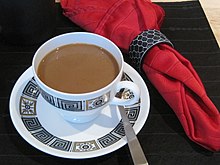White coffee: Difference between revisions
No edit summary Tags: Mobile edit Mobile web edit |
|||
| Line 5: | Line 5: | ||
== Coffee with whitener == |
== Coffee with whitener == |
||
[[File:Coffee cup.JPG|thumb|Coffee with whitener]] |
[[File:Coffee cup.JPG|thumb|Coffee with whitener]] |
||
In many English-speaking countries, "white coffee" is used to refer to regular black [[coffee]] that has had milk, cream or some other "whitener" added to it, though the term is almost entirely unheard of in the US, where the same beverage might be called "coffee light" in the [[New York City]] area, "light coffee", "coffee with milk," or "regular coffee" in [[New England]] and New York City. Cream varieties |
In many English-speaking countries, "white coffee" is used to refer to regular black [[coffee]] that has had milk, cream or some other "whitener" added to it, though the term is almost entirely unheard of in the US, where the same beverage might be called "coffee light" in the [[New York City]] area, "light coffee", "coffee with milk," or "regular coffee" in [[New England]] and New York City. Cream varieties, often called "creamers" in the [[United States|US]], can be made of dairy [[milk]], [[corn syrup]] derivatives, [[soy]], or nut products. Sweeteners used include cane [[sugar]] or artificial ingredients. |
||
White coffee should be distinguished from [[café au lait]], in that white coffee uses chilled or room-temperature milk or other whitener, while café au lait uses heated or steamed milk. |
White coffee should be distinguished from [[café au lait]], in that white coffee uses chilled or room-temperature milk or other whitener, while café au lait uses heated or steamed milk. |
||
Revision as of 16:22, 28 February 2017
This article needs additional citations for verification. (January 2015) |
White coffee can refer to any of a number of different kinds of coffees or coffee substitutes worldwide.
Coffee with whitener

In many English-speaking countries, "white coffee" is used to refer to regular black coffee that has had milk, cream or some other "whitener" added to it, though the term is almost entirely unheard of in the US, where the same beverage might be called "coffee light" in the New York City area, "light coffee", "coffee with milk," or "regular coffee" in New England and New York City. Cream varieties, often called "creamers" in the US, can be made of dairy milk, corn syrup derivatives, soy, or nut products. Sweeteners used include cane sugar or artificial ingredients.
White coffee should be distinguished from café au lait, in that white coffee uses chilled or room-temperature milk or other whitener, while café au lait uses heated or steamed milk.
Other coffee drinks
Indonesia
In Indonesia, the term white coffee or kopi putih refers to the coffee beans which are roasted in shorter period than regular coffee beans. The shorter roasting period generate the lighter-colored coffee beans, called biji kopi putih or the white coffee beans. The white coffee beans are stiffer and different in taste than regular coffee beans. The white coffee has a savory and mild taste compared to its regular counterpart. Due to its shorter roasting time, white coffee has a higher concentration of caffeine.
Lebanon
Lebanese white coffee "ahweh bayda" is a caffeine-free drink made from water, orange blossom water, and sweetened with sugar if desired. Although not the most common substitute for coffee it is occasionally served in lieu of coffee (Turkish coffee). Ahweh bayda is traditionally thought to have a soothing effect when taken.
Malaysia
In Malaysia, the original white coffee started in the town of Ipoh and was a drink made from beans roasted in margarine, ground, brewed and served with sweetened condensed milk. This indigenous style of coffee continues to be popular throughout the country. However, “white coffee” in Malaysia often simply refers to how the drink is prepared and presented - with added milk or creamer.
Overseas visitors finding the margarine-roasted coffee beans unorthodox (due to their slight caramelized flavor) are often misled into believing that there is a type of coffee bean endemic to Malaysia called the "white coffee bean". The beans used are invariably imported beans roasted to a light color.
Local coffee manufacturers now mix instant coffee powder with non-dairy creamer or whitener and sugar, and market the 3-in-1 mixture as white coffee as well. The mixture is preferred by Malaysians at home or in the office as a convenient easy-to-prepare coffee drink. The advisability, however, of consuming instant coffee mixed with non-dairy creamer and sugar daily is slowly coming into question, with some manufacturers now taking the sugar out of the mixture, and marketing the 2-in-1 mixture as sugar-free white coffee.
United States
In the United States, white coffee may also refer to coffee beans which have been roasted to the yellow roast level and when prepared as espresso produces a thin yellow brew, with a high acidic note. There is a debate that white coffee is more highly caffeinated than darker roasted coffee. In fact, the sublimation point of caffeine is 352 °F (178 °C), about one hundred degrees lower than the typical very dark roast. Coffee beans can catch fire at temperatures lower than 500 °F (260 °C).[1][2] White coffee is generally used only for making espresso drinks, not simple brewed coffee. With shorter roasting times, natural sugars are not caramelized within the coffee beans, leaving no bitter aftertaste. The flavor of white coffee is frequently described as nutllike, with pronounced acidity.
Yemen
There is also a form of white coffee, native to Yemen, which refers to the ground shell of the coffee bean. This form of coffee earns its name from its color, and is brewed in the same manner as regular coffee, only with some spices added.
References
- ^ "caffeine msds sheet". tamu.edu. Retrieved 18 January 2015.
- ^ "Coffee Terms - Roasting". coffeeterms.com. Retrieved 18 January 2015.
